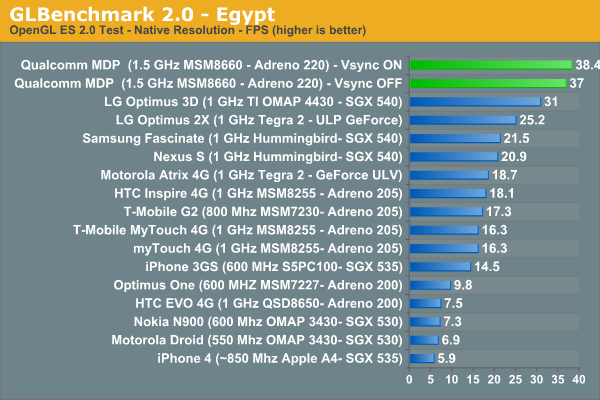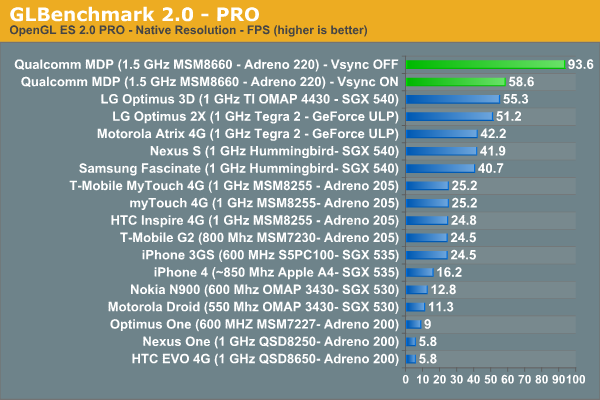Dual Core Snapdragon GPU Performance Explored - 1.5 GHz MSM8660 and Adreno 220 Benchmarks
by Brian Klug on March 30, 2011 4:29 PM EST- Posted in
- Smartphones
- Snapdragon
- Qualcomm
- Adreno
- MSM8660
- MDP
- Mobile
GLBenchmark 2.0
GLBenchmark 2.0 – as its name implies – tests OpenGL ES 2.0 performance on compatible devices across multiple software platforms. The suite includes two long benchmarking scenarios with a demanding combination of OpenGL ES 2.0 effects - texture based and direct lighting, bump, environment, and radiance mapping, soft shadows, vertex shader based skinning, level of detail support, multi-pass deferred rendering, noise textures, and ETC1 texture compression. In addition, there's a large suite of subtests and feature tests.
GLBenchmark 2.0 is the best example of an even remotely current 3D game running on this class of hardware–even then this is a bit of a stretch. GLBenchmark 2.0 is still our current go-to test as it is our best best for guaging real world performance, even across different mobile OSes. Keep in mind that with GLBenchmark 2.0 we still cannot run at any resolution than native – in this case 800x480 (WVGA) – and the same applies for other devices in the suite, they're all at respective native resolutions. GLBenchmark 3.0 will fix this somewhat with the ability to render into an off-screen buffer of arbitrary size.

We never formally reviewed the T-Mobile MyTouch 4G, but have one nonetheless and have included it in our benchmark numbers a few times. Likewise, I purchased an HTC Inspire 4G for personal use which we'll review soon. The importance of these two devices is that they represent the current generation of single-core Snapdragon SoCs with Adreno 205 graphics. Comparatively, the 1.5 GHz MSM8660 with Adreno 220 is 2.2x faster than the 1 GHz MSM8655 with Adreno 205.
Interestingly enough our run through Egypt came slightly higher with Vsync on than it did off - we're just showing the margin of error here.

Pro is a less challenging test than Egypt, as it's simply the GLBenchmark 1.x main suite with OpenGL ES 2.0 features and shaders. Already we're at the framerate cap here on both MSM8660 and likely OMAP 4430. Pro likewise demonstrates huge gains from Adreno 205 to Adreno 220 - in this case 3.7x.











70 Comments
View All Comments
tipoo - Wednesday, March 30, 2011 - link
Any idea why the iPhone 4 does worse than even the 3GS in the second page benchmarks? And would it be possible to throw an iPad 2 in the comparison, as the dual core A5 chip is more like what this will be competing against?Thanks
Brian Klug - Wednesday, March 30, 2011 - link
The reason for the iPhone 4 lagging iPhone 3GS is display resolution, which unfortunately right now we can't test at anything other than native. GLBenchmark 3.0 will change a lot of that as we'll be able to render off-screen at an arbitrary (common) size.I didn't include the A5 because I didn't include any tablets at all in the comparison.
-Brian
FATCamaro - Wednesday, March 30, 2011 - link
iphone 4 has 4 times the pixels to draw to as opposed to the 3GS. The iPad 2 isn't in the comparison because it would blow everything out of the water.DJMiggy - Wednesday, March 30, 2011 - link
wat?choirbass - Wednesday, March 30, 2011 - link
http://www.anandtech.com/show/4225/the-ipad-2-revi...B3an - Wednesday, March 30, 2011 - link
wateva.GLBenchmark 2.0 Egypt:
iPad 2 = 44
This phone (Adreno 220) = 38.3
GLBenchmark 2.0 Pro:
iPad 2 = 57.6
This phone (Adreno 220) = 93.6
Or Adreeno 220 with vSync = 58.8
Yeah the iPad 2 has a higher res screen, but it's not that much higher. The Adreeno 220 certainly competes. Not bad for a device thats a lot smaller.
snoozemode - Wednesday, March 30, 2011 - link
Not that much higer? The iPad 2 has twice the amount of pixels compared to this phone.choirbass - Wednesday, March 30, 2011 - link
within 6-12 months or so, there should be closely competitive gpus again... always a refresh and release cycle.jalexoid - Wednesday, March 30, 2011 - link
It's not all about the pixels.therealnickdanger - Thursday, March 31, 2011 - link
If you are rendering in native resolution, then yes, yes it is.iPad = 1024x768 = 786,432 = 100%
iPhone = 960x640 = 614,400 = 84%
Adreno = 800x480 = 384,000 = 48%
Adreno doesn't even have to work half as hard as the iPad. While impressive for 480p, Adreno has work to do to catch up to Apple's GPU for higher resolutions.